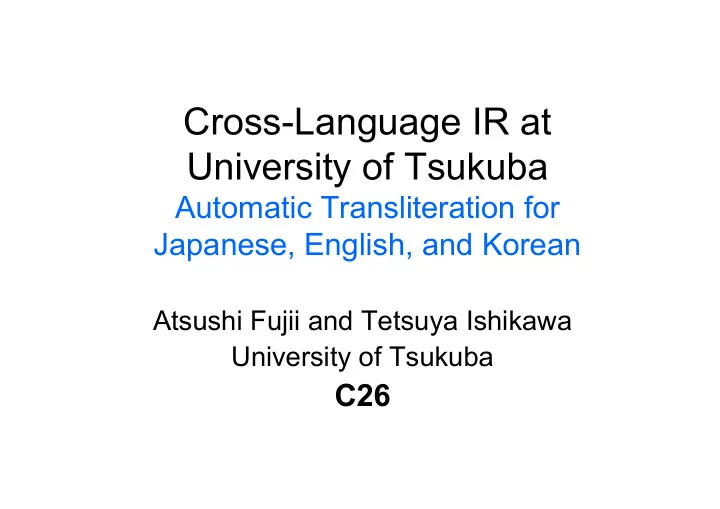

Cross-Language IR at University of Tsukuba Automatic Transliteration for Japanese, English, and Korean Atsushi Fujii and Tetsuya Ishikawa University of Tsukuba C26
Motivation • We developed an automatic transliteration method for Japanese and English CLIR – effective in translating foreign words spelled out by phonetic alphabet (e.g., Katakana) – evaluation since NTCIR-1 – the method has been used in commercial cross-language patent IR service • In NTCIR-4 CLIR, we applied our method to Korean and realized JEK transliteration in a single framework 2
Basis of transliteration • spelling out foreign words (loanwords) by phonetic alphabet – technical terms and proper names – often out-of-dictionary words • examples – dioxin → ダイオキシン, 다이옥신 – Yugoslavia → ユーゴスラビア, 유고슬라비아 • back-transliteration – process to identify the source English word 3
Overview of our CLIR system Focus of today’s talk Query Query Query Translation Ranked IR engine Document document (Okapi) collection list 4
Example of J-E Query Translation レジスタ転送言語 consulting dictionary lexical segmentation レジスタ 転送 言語 transliteration resister transfer language resistor transmission disambiguation register transport register transfer language 5
Query Translation (cont.) • compound query term S and a translation candidate T S = s1, s2, …, sN si and ti are base words T = t1, t2, …, tM • compute P(T|S) = P(S|T) ・ P(T) translation model language model • select the candidate with max P(T|S) 6
Translation model • P(S|T) = Π P(si | ti) si and ti are base words comprising S and T • heuristics and EM algorithm to correspond dictionary entries on a word-by-word basis Information retrieval system 情報検索システム retrieval model 検索モデル Information extraction system 情報抽出システム patent information processing 特許情報処理 • estimate P(si | ti) 7
Language model • word-based trigram model • 100K vocabulary in a target document collection • Palmkit was used – compatible with CMU-LM toolkit 8
Transliteration method • out-of-dictionary word S and a transliteration candidate T S = s1, s2, …, sN T = t1, t2, …, tM si and ti are letters (substrings of words) • compute P(T|S) = P(S|T) ・ P(T) language model transliteration model (word unigram) • select the candidate with max P(T|S) 9
Transliteration dictionary • dictionary for transliteration includes correspondence b/w source and target words on a phonogram-by-phonogram basis • we use Roman representation as a pivot 10
Producing J/E dictionary 1. extract Japanese Katakana words and English translations from J-E dictionary 2. romanize Katakana words 3. correspond romanized Katakana and English words on a letter-by-letter basis 4. find the best correspondence 11
Example matrix テキスト( te-ki-su-to ) text テ キ ス ト $ t 3 1 2 3 0 e 0 0 0 0 0 x 1 2 1 1 0 t 3 1 2 3 0 $ 0 0 0 0 3 By performing the same テ te process for all Katakana キス x entries, we produce ト t transliteration dictionary 12
Extension to other languages • our transliteration method can be applied to any language if represented by Roman characters • no existing method has been used and evaluated in CLIR for more than two languages – our experiment was the first effort to explore this issue 13
Problems in Korean • romanization of Korean words is more difficult than that of Katakana words – # of Hangul characters is approx. 11,000 – one-to-one mapping b/w Hangul and Roman characters is not easy • both conventional Korean words and foreign words are written by Hangul characters – detection of foreign words in Korean dictionary is crucial 14
Romanizing Korean words • Hangul character consists of three types of consonants last consonant is optional – first consonant (19) – vowel (21) – last consonant (27 + 1) • # of possible combinations is 11,172 (# of common characters is approx. 2,000) • We used Unicode, in which characters are coded according to consonants 15
Fragment of Unicode table • first consonant changes every 21 lines • vowel changes every line and repeats every 21 lines • last consonant changes every column • Hangul characters can be identified by pronunciation • only map b/w consonants and Roman characters is needed 16
Fragment of Unicode table • first consonant changes every 21 lines • vowel changes every line and repeats every 21 lines • last consonant changes every column • Hangul characters can be identified by pronunciation • only map b/w consonants and Roman characters is needed 17
Fragment of Unicode table • first consonant changes every 21 lines • vowel changes every line and repeats every 21 lines • last consonant changes every column • Hangul characters can be identified by pronunciation • only map b/w consonants and Roman characters is needed 18
Fragment of Unicode table • first consonant changes every 21 lines • vowel changes every line and repeats every 21 lines • last consonant changes every column • Hangul characters can be identified by pronunciation • only map b/w consonants and Roman characters is needed 19
Detecting foreign words in Korean • compute the phonetic similarity b/w romanized Hangul words and their translations (either English or Japanese) • discard translation pairs whose similarity is below a threshold – conventional Korean words are discarded • foreign word entries remained 20
Experiments (J/E) <TITLE>, mean average precision (rigid) Languages #Entries w/o w/ transliteration transliteration J-E 1M 0.2174 0.2182 < E-J 1M 0.1250 0.1250 = J-E (EDICT) 108K 0.1147 0.1383 < E-J (EDICT) 108K 0.0612 0.0857 < transliteration was effective for small dictionaries 21
Experiments (Korean) <TITLE>, mean average precision (rigid) Languages w/o transliteration w/ transliteration J-K 0.2177 0.2457 < K-J 0.1486 0.1746 < E-K 0.2026 0.2153 < K-E 0.1017 0.1231 < transliteration was also effective for Korean 22
Conclusion • realized transliteration for Japanese, English, and Korean in a single framework • evaluated its effectiveness in NTCIR-4 CLIR task 23
Recommend
More recommend